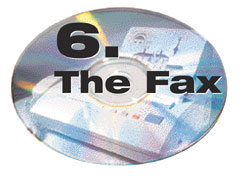 |
Next to the telephone, the fax machine is the lowest common denominator of electronic communications in business. If you have nothing else, chances are you have a fax, and that is enough to tuck documents right into the data stream. Bar-codes on cover sheets now can route transmissions as scanned records directly into document management systems.
Facsimile transmission was patented in 1843 by Alexander Bain, a Scottish mechanic. He used a stylus on a pendulum to scan an image on a metal surface and transmit it by wires to a corresponding device that reproduced it. He was trying to solve the problem of synchronizing clocks separated by distance. Seven years later when the telegraph was invented, Bains technology was developed into the fax machine.
| RELATED LINKS |
| 10 Electronic Technologies That Changed Construction |
|
1. The Internet Collaboration Is Evolving From Sharing to Managing |
| 2. Computer Aided Design CAD Pioneers Gave Desktop PCs A Full Range of Electronic Drafting |
|
3. Lasers Lasers Have Become Common Element in Industrys Toolbox |
|
4. Analysis Software Speed and Power of Computation Opens Doors to New Possibilities |
|
5. Personal Computers Personal Computers Empowered Users and Launched a New Age |
|
6. The Fax Speeding the Pace of Business and Shrinking the Globe |
|
7. Critical Path Method Network Logic Was Aided By Mainframe Power |
|
8. Calculators Calculators Built on Microchips Doomed Slide Rules |
|
9. Mobile Communications Contractors Were Early Adopters of Mobile Comms |
|
10. Global Positioning Systems Location-Based Technologies Track Construction Operations |
|
What's Next? Innovations Are Ready for Trial and Adoption, But Great Gains Will Take Major Change |
By 1914, news reports and photos were being faxed on dedicated lines and radio waves. Other business uses gradually developed, but the machines were big and cranky and required special paper.
"The first faxes didnt take the market by storm because they were so difficult to use," says Ric Jackson, managing director of FIATECH, Reston, Va. "The first time I used one, it was so complicated. You had to start by figuring out what kind of fax the person had on the other endwe didnt have interoperability."
In 1966, Xerox introduced the Magnafax Telecopier, a 46-lb facsimile machine that was easier to use and could be connected to any telephone line. It took six minutes to transmit a page, which was a big step forward. But the real commercial break came in 1973 when Xerox introduced the first plain-paper, desktop, telephone-line fax machine. The modern fax was born.
By 1983, there were 3,000 fax machines in the U.S. Five years later, there were 4 million. Fax machines revolutionized business communications by cutting the time it took to exchange documents, such as bid forms, requests for information and change orders, to seconds worldwide. Faxes shrank the globe. The automatic machines could chatter to each other across the world overnight and the documents would be in hand in the morning.
"The fax makes perfect sense," says Dick Farris, co-founder and chief technology officer of Primavera Systems Inc., Bala Cynwyd, Pa. Perhaps that is why many take it for granted today.
|

Post a comment to this article
Report Abusive Comment